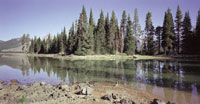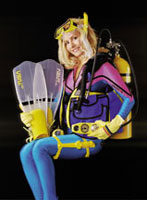The CanoScan FB 1200S
For the many photographers
who are setting up a digital darkroom, and have medium and large format
film to scan, Canon has a very attractive scanner solution. The CanoScan
FB 1200S offers high 1200dpi optical resolution with professional-level
film scanning quality at a fraction of the cost for this type of scanner
last year. Canon has accomplished this by using a two-pass technique
to achieve the 1200dpi optical resolution, using what they call a Variable
Refraction Optical System. In essence this is an adoption of pixel shift
technique found in conventional video cameras. This method uses larger
CCDs than a conventional 1200dpi scanner providing a higher CCD element
sensitivity. |
|||
Using The CanoScan FB 1200S
With Film Adapter. The compact and lightweight CanoScan FB 1200S, even
including the transparency adapter lid with its illumination source, was
quite easy and straightforward to install and set up. Likewise the Canon
software was equally smooth and easy to install, even though the transparency
scanning software for the film adapter is separate and called FilmGet.
So first of all, of the three types of media I used for testing, color
prints including a 5x7 IT-8 target, color transparencies including a 4x5
film IT-8 target, and 120 size color negatives, I began my tests using
ScanGear to scan prints. Scanning from within Photoshop on a PC with Windows
98 using the TWAIN driver provides a generous window with large preview
and logically designed easy to use adjustments for all of the primary
attributes of image quality. |
|||
Evaluation And Recommendation. The obvious question I'm sure is how does the CanoScan FB 1200S compare to conventional more expensive 1200dpi scanners. Fortunately I recently tested and reviewed such a scanner, so I was able to compare the results. First off the Canon ScanGear and FilmGet software is not as sophisticated with features like selective color adjustment, but applied to my tests that did not make a significant difference because nothing is lost by making selective color hue or balance adjustments post-scan in Photoshop with a 3.3 dynamic range the FB 1200S is quite adequate for film scanning, although it is not as great a range as some more expensive scanners. However, I was very pleasantly surprised to find the scan quality of full-tone transparency film images were very clean and smooth at all levels of density. In the area of image sharpness, the CanoScan was not quite the equal of the more expensive scanner, which I would assess to the larger CCD element sensor size of the Canon. This distinction was however, only visible on-screen at high image magnification. In prints of the images the results from the two scanners were indistinguishable in sharpness. The one performance factor of the CanoScan FB 1200S that is not equal to more expensive scanners is in scan speed. |
|||
Adding everything up based on my work with the CanoScan I found the scanner's capabilities combined with its affordability make it an ideal complement to an enthusiast's digital darkroom. Any photographer who uses 120 or 4x5 film, and has an need for print and document scanning will be well served by the CanoScan FB 1200S. At this new price level I would afford the FB 1200S just for proofing roll and sheet film--it'll proof entire rolls of 35mm and 120 film at a clip, or four 4x5s, and send the scan directly to your printer. And although I wouldn't recommend it as a primary 35mm film scanner because 1200dpi optical is not enough resolution, scans of 35mm will yield quite decent 5x7 prints. I believe with this new 1200dpi scanner Canon has made the digital darkroom a much more attractive possibility for many photo enthusiasts. For more information, call (800) 652-2666 or visit either www.ccsi.canon.com or www.canoscan.com. Technical Specifications |
- Log in or register to post comments





































